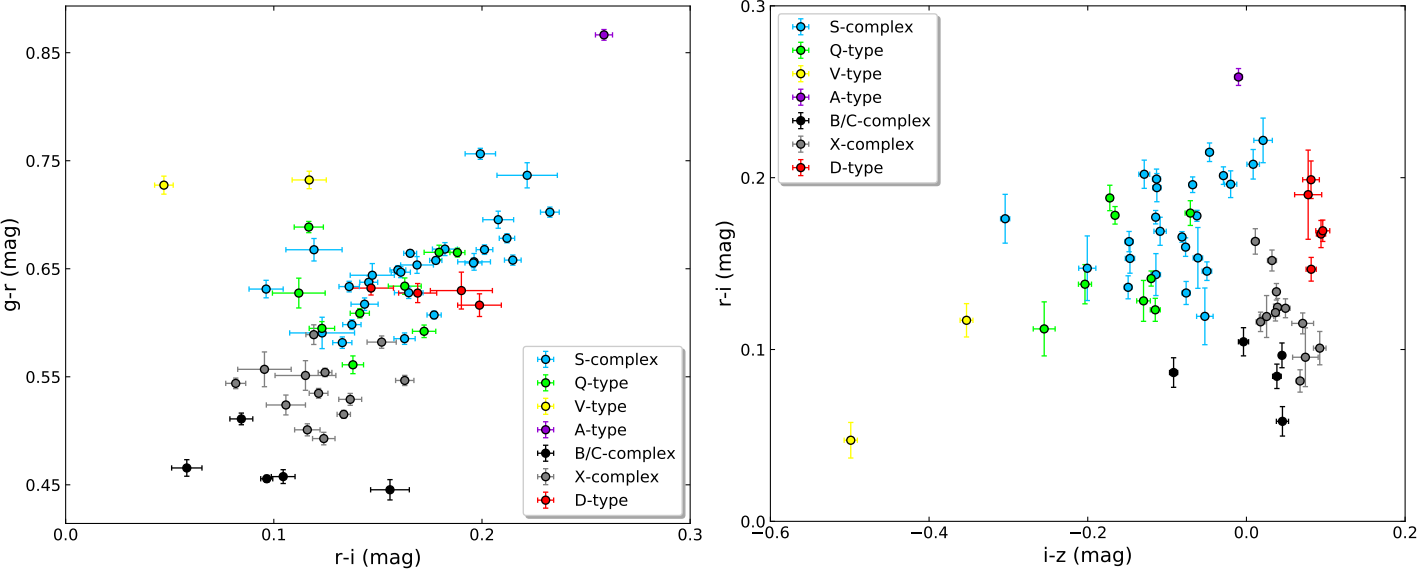- 1Astronomical Institute of the Romanian Academy, Bucharest (Romania)
- 2Instituto de Astrofísica de Canarias, Tenerife (Spain)
- 3Universidad de La Laguna, Departamento de Astrofísica, Tenerife (Spain)
- 4Isaac Newton Group of Telescopes (ING),Canary Islands, (Spain)
- 5Faculty of Sciences, University of Craiova, (Romania)
The near-Earth asteroids (NEAs) represent excellent scientific opportunities to study the dynamical and physical properties of small bodies of the Solar System. Moreover, the celestial bodies with sizes lower than one km can be studied using a variety of techniques, thanks to the fact that they come close to Earth orbit.
We report the preliminary results of an ongoing observational program for obtaining the visible color indexes of NEAs. Our survey use the MuSCAT2 instrument [1] mounted on the 1.52 m Telescopio Carlos Sánchez located at Teide Observatory (Canary Islands, Spain). The setup allows us to obtain simultaneous imaging in the g (400–550nm), r (550–700 nm), i( 700–820 nm), and zs (820–920nm) bands. The visible colors have proven to be efficient to broadly differentiate between the major compositional groups [2]. Thus, by using MuSCAT2 instrument we can obtain the spectro-photometric classification for a large number of NEOs. The simultaneous imaging allows to study the relation between the rotational properties and the taxonomic type. It can also reveal possible heterogeneous compositions of the observed targets.
Fig. 1 The absolute magnitude distribution of NEAs observed with TCS – MuSCAT2 instrument
The program started in March 2018 with one or two observing nights allocated on every month. A total of 267 spectro-photometric observational sets were collected. They correspond to 198 NEAs with the absolute magnitudes distributed in the range of 12 -24 mag (Fig. 1). Our schedule gave priority to the targets observed by radar, to potentially hazardous asteroids and to those suitable for a space mission. We also considered the newly discovered objects. Most of these are very small objects (in general smaller than 300m) and the opportunities to study them are rare.

Fig. 2 The color-color diagrams of objects with known visible colors and spectral classification, used as training sets in the K-Nearest Neighbors algorithm.
We used the Photometry Pipeline (PP) software [3] and several Python scripts for reducing the data. We applied the K-Nearest Neighbors (KNN) algorithm to obtain the spectro-photometric classification. For the training set we used the 86 asteroids for which spectral data is also available and the taxonomic type is known ([4], [5]). We grouped the taxonomic classes in seven groups, namely Q-type and S-complex (similar to silicate asteroids), V-type (specific to basaltic objects), A-type (an olivine-dominated composition), B/C-complex (similar to carbonaceous meteorites), X-complex and D-type (reddish surfaces – possible cometary nature). The color-color diagrams of this sample used for training is shown in Fig. 2. The classification results are shown in Fig. 3.
Fig 3. The taxonomic distribution of the observed sample
By assigning a probability for each classification we quantified the effect of color errors. This was derived by applying a Monte-Carlo approach. We generated 10000 simulated values for each of the colors of an asteroid by using a normal distribution where the mean is the observed color and the standard deviation is the color error. The KNN classifier was applied for each of these colors. The reported class is the one predicted in most cases and the probability is the occurrence rate.
Acknowledgments
MP, JL, JdL, and DM acknowledge support from the ESA P3NEOI and NEOROCKS projects. The work of MP, GNS, and RMG was supported by a grant of the Romanian National Authority for Scientific Research – UEFISCDI, project number PN-III-P1-1.1-TE-2019-1504. This work was developed in the framework of EURONEAR collaboration.
References
[1] Narita, Norio et al.; Journal of Astronomical Telescopes, Instruments, and Systems, Volume 5, id. 015001 (2019).
[2] Parker, A.; Icarus, Volume 198, Issue 1, p. 138-155 (2008).
[3] Mommert, Michael; Astronomy and Computing, Volume 18, p. 47-53 (2017).
[4] Popescu, M et al.; Astronomy & Astrophysics, Volume 627, id.A124, 21 pp (2019).
[5] Binzel R. P., et al. 2019, Icarus, 324, 41
How to cite: Popescu, M., de León, J., Licandro, J., Nicolae Simion, G., Morate, D., Văduvescu, O., Luis Rizos, J., Medeiros, H., and Mihai Gherase, R.: Simultaneous observations in four optical bands of near-Earth asteroids using TCS/MuSCAT2 instrument, Europlanet Science Congress 2021, online, 13–24 Sep 2021, EPSC2021-820, https://doi.org/10.5194/epsc2021-820, 2021.

